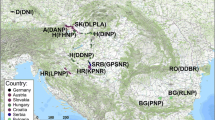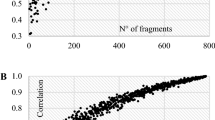Abstract
The species Avicennia germinans in natural and reforested areas was analyzed to obtain information about its genetic diversity in a highly disturbed mangrove ecosystem and to generate a useful tool for determining the donor and receptor populations of propagules. Tissue of 149 individuals was collected in the protected areas of the Tayrona National Natural Park (Tayrona-NNP) and the Salamanca Island Parkway (Salamanca-IP). A total of 38 alleles were found in seven microsatellite loci, leading to the detection of high levels of heterozygosity in the two protected areas. The impact of the highway on the Salamanca-IP-south population was shown when the inbreeding coefficient from younger individuals was compared with older ones; inbreeding increased 4.2 times. The inbreeding coefficient in the reforested area was 2.2 times higher than that in the Salamanca-IP-south zone. Thus, for future reforestations in this area, the collecting of propagules should come from two sectors—one to the north of the highway including Tayrona-NNP and the other to the south. Finally, we consider that the viability of the reforested population in the short and medium term would be improved if good reforestation practices are implemented for A. germinans.


Similar content being viewed by others
References
Arbeláez-Cortés, E., M. Castillo-Cárdenas, N. Toro-Perea & H. Cárdenas-Henao, 2007. Genetic structure of the red mangrove (Rhizophora mangle L.) on the Colombian Pacific detected by microsatellite molecular markers. Hydrobiologia 583: 321–330.
Belkhir, K. P., L. Borsa, N. Chikhi, N. Raufaste & F. Bonhomme, 2004. GENETIX 4.03, Logiciel sous Windows pour la genetique des populations. Laboratoire Genome, Populations, Interactions, CNRS UMR 5000, Université de Montpellier II, Montpellier, FR.
Cerón-Souza, I., N. Toro-Perea & H. Cárdenas-Henao, 2005. Population genetic structure of neotropical mangrove species on the Colombian Pacific coast: Avicennia germinans (Avicenniaceae). Biotropica 37: 258–265.
Cerón-Souza, I., E. Rivera, S. Funk & O. Mcmillan, 2006. Development of six microsatellite loci for black mangrove (Avicennia germinans). Molecular Ecology Notes 6: 692–694.
Ceska, J., J. Affolter & J. Hamrick, 1997. Developing a sampling strategy for Baptisia arachnifera based on allozyme diversity. Conservation Biology 11: 1133–1139.
Dodd, R. S. & Z. Afzal-Rafii, 2002. Evolutionary genetics of mangroves: continental drift to recent climate change. Tree 16: 80–86.
Dodd, R. S., Z. Afzal-Rafii, N. Kashani & J. Budrick, 2002. Land barriers and open oceans: effects on gene diversity and population structure in Avicennia germinans L. (Avicenniaceae). Molecular Ecology 11: 1327–1338.
Elster, C., 2000. Reasons for reforestation success and failure with three mangrove species in Colombia. Forest Ecology and Management 131: 201–214.
Excoffier, L., G. Laval & S. Schneider, 2005. Arlequin3.1: an integrated software package for population genetics data analysis. Evolutionary Bioinformatics Online 1: 47–50.
Fenster, C. & L. Galloway, 2000. Population differentiation in annual legume: genetic architecture. Evolution 54: 1157–1172.
Frankham, R., J. Ballou & D. Briscoe, 2002. Introduction to Conservation Genetics. Cambridge University Press, Cambridge, UK.
Hufford, K. & S. Mazer, 2003. Plant ecotypes: genetic differentiation in the age of ecological restoration. Trends in Ecology and Evolution 18: 147–155.
Jiménez, J. & A. Lugo, 1985. Avicennia germinans (L.) L. Black mangrove. Avicenniae. Verbena family. U.S. Department of Agriculture, Southern Forest Experimental Station, Institute of Tropical Forestry. Report SO-ITF-SM-4. 6 pp.
Kalinowski, S. T. & M. L. Taper, 2006. Maximum likelihood estimation of the frequency of null alleles at microsatellite loci. Conservation Genetics 7: 991–995.
Kimura, M. & J. Crow, 1964. The number of alleles that can be maintained in a finite population. Genetics 49: 725–738.
Levin, D. & Z. Bulinska-Radomska, 1998. Effects of hybridization and inbreeding on fitness in phlox. American Journal of Botany 75: 1632–1639.
Lewis, P. & D. Zaykin, 2000. Genetic data analysis: computer program for the analysis of allelic data. Vers. 1.0, free program distributed by the authors over internet from the GDA home page at http://alleyn.eeb.uconn.edu/gda/.
Maguire, T., P. Saenger, P. Baverstock & R. Henry, 2000. Microsatellite analysis of genetic structure in the mangrove species Avicennia marina (Forsk) Vierh. (Avicenniaceae). Molecular Ecology 9: 1853–1862.
Melville, F. & M. Burchett, 2002. Genetic variation in Avicennia marina in three estuaries of Sydney (Australia) and implications for rehabilitation and management. Marine Pollution Bulletin 44: 469–479.
Miller, M., 1997. Tools for population genetic analysis TFPGA vers. 1.3. Department of Biological Sciences, Northern Arizona University, Flagstaff, AZ; mpm2@jan.ucc.nau.edu.
Montalvo, A. & N. Ellstrand, 2000. Transplantation of the subshrub Lotus scoparius: testing the home-site advantage hypothesis. Conservation Biology 14: 1034–1045.
Nei, M., 1978. Estimation of average heterozygosity and genetic distance from a small number of individuals. Genetics 89: 583–590.
Nettel, A. & R. Dodd, 2007. Drifting propagules and receding swamps: genetic footprints of mangrove recolonization and dispersal along tropical coasts. Evolution 61: 958–971.
Nettel, A., F. Rafii & R. Dodd, 2005. Characterization of microsatellite markers for the mangrove tree Avicennia germinans L. (Avicenniaceae). Molecular Ecology Notes 5: 103–105.
Ostermeijer, J., R. Alternburg & J. Den Nijs, 1995. Effects of outcrossing distance and selfing on fitness components in the rare Gentiana pneumonanthe. Acta Botanica Neerlandica 44: 257–268.
Peakall R. & P. Smouse, 2006. GenAlEx 6. Genetics analysis in excel. Population genetic software for teaching and research. The Australian National University.
Raymond, M. L. & F. Rousset, 1995. An exact test for population differentiation. Evolution 49: 1280–1283.
Sánchez–Páez, H., L. Alvarez, F. Pinto, A. Sánchez–Páez, J. Pino, I. García & M. Acosta, 1997. Diagnóstico y zonificación preliminar de los manglares del Caribe de Colombia. Ministerio del Medio Ambiente – OIMT. Santafé de Bogotá, Colombia.
Sánchez-Páez H., G. Ulloa, H. Tavera & W. Gil, 2005. Plan de manejo integral de los manglares de la zona de uso sostenible del sector estuarino de la Bahía de Cispatá- Departamento de Córdoba. Colombia. ISBN 958-33-8278-7.
Sanguinetti, C., E. Dias & A. J. Simpson, 1994. Rapid silver staining and recovery of PCR products separated on polyacrylamide gels. Biotechniques 17: 915–919.
Slatkin, M., 1987. Gene flow and the geographic structure of natural populations. Science 236: 787–792.
Sun, M., K. C. Wong & S. Y. Lee, 1998. Reproductive biology and population genetic structure of Kandelia candel (Rhizophoraceae), a viviparous mangrove species. American Journal of Botany 85: 1631–1637.
Tomlinson, P., 1986. The Botany of Mangroves. Cambridge University Press, Cambridge, UK.
UVIGELSTARTMW Vers. 11.01 for Windows UVI, 1999–2003. UVITec. Cambridge, UK. http://www.uvitec.co.uk/products/uvisoft/index.html.
VIPIS, 2004. Plan de Manejo Parque Nacional Natural Vía Parque Isla Salamanca Parques nacionales naturales de Colombia, Dirección territorial caribe Santa Marta (Magdalena), Subdirección Técnica. Ministerio de Ambiente, Vivienda y Desarrollo Territorial. Informe final. Santa Martha, Magdalena, Colombia.
Wright, S., 1969. Evolution and the genetics of populations. The theory of gene frequencies. University of Chicago Press, Chicago.
Acknowledgements
We are grateful to IFS (code D3936-1/D3936-2), COLCIENCIAS (code 110609 17768) and to the Universidad del Valle for financing the project ‘Genetic conservation of black mangrove (A. germinans) in Colombia: Analysis of population structure in natural and reforested environments’. We thank Heiber Cárdenas and the anonymous reviewers for the critical reading of the manuscript and their helpful comments. We would also like to express our gratitude to SINA-MADTV (Contract 005-12-07-2007 MADTV) for access to genetic resources.
Author information
Authors and Affiliations
Corresponding author
Additional information
Handling editor: C. Sturmbauer
Rights and permissions
About this article
Cite this article
Salas-Leiva, D.E., Mayor-Durán, V.M. & Toro-Perea, N. Genetic diversity of black mangrove (Avicennia germinans) in natural and reforested areas of Salamanca Island Parkway, Colombian Caribbean. Hydrobiologia 620, 17–24 (2009). https://doi.org/10.1007/s10750-008-9611-x
Received:
Revised:
Accepted:
Published:
Issue Date:
DOI: https://doi.org/10.1007/s10750-008-9611-x




